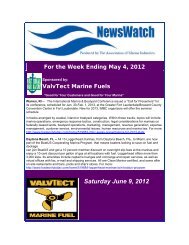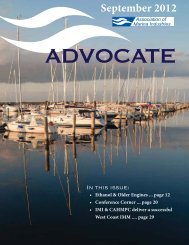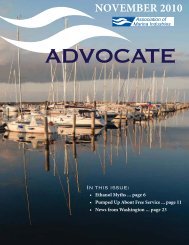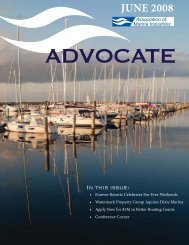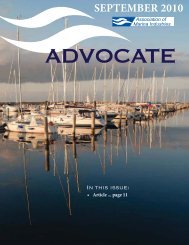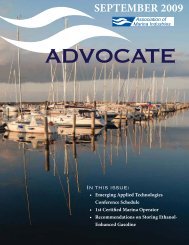MAY 2011 - Association of Marina Industries
MAY 2011 - Association of Marina Industries
MAY 2011 - Association of Marina Industries
You also want an ePaper? Increase the reach of your titles
YUMPU automatically turns print PDFs into web optimized ePapers that Google loves.
Technical Advice Continued from Page 22to develop ISO standards but it became increasingly clear thatthe new standards were likely to move forward with the potentialto become a huge barrier to trade. A series <strong>of</strong> meetingwere held and Hale, along with NMMA’s Tom Marhevco andLars Granholm, began to shuttle back and forth across the Atlanticto participate on the committees that were tasked withdeveloping the new marine standards, most <strong>of</strong> which woundup being based directly on the ABYC standards. Hale saidthe reason for this was simple: After centuries <strong>of</strong> mistrust, thevarious European countries would have too much difficultyadopting one nation’s standards over another. The French, forexample, would never have considered giving up their standardsin favor <strong>of</strong> the English and vice versa. Hale said the USstandards were the obvious compromise; they were morecomprehensive than any <strong>of</strong> the other standards, weren’t tiedto a government agency, and were the only ones based solelyon statistics and data from actual boating accidents.Moyer said the request by ISO to use the ABYC standardswas greeted at first with some skepticism but if there wasgoing to be an international standard, it was in everyone’sinterest that they be as much like the ABYC standards aspossible. An international boating industry magazine publishedan editorial stating that the United States “comprisedat least half <strong>of</strong> the world’s recreational boat market andprobably a good deal more.” Moyer said nobody wantedto build boats to two completely different standards; it waseasier to supply the standard and then work to make sure itwasn’t changed, or changed as little as possible.That wasn’t always easy; ABYC was one <strong>of</strong> 17 voices and some<strong>of</strong> what was finally published was completely different thanthe approach taken by the ABYC standards. Many <strong>of</strong> thedifferences were difficult to resolve. ISO standards includedscantlings, for example, as well as an A - B - C - D rating systemto identify where a boat was intended to be used. Despitesome significant differences, when the ISO standards wentinto effect on June 16, 1998, ABYC Technical Board and ProjectTechnical Committees began working to see which ones itmight feel comfortable accepting. Several that were the sameor largely the same were accepted immediately, which inevitablyraised the question about ABYC’s future role in the standards-makingprocess: What would happen if all <strong>of</strong> the ISOstandards were eventually accepted? Once an ISO standardis accepted, it would replace the comparable ABYC standardand the ABYC would then give up control <strong>of</strong> the standard.Moyer said, no one thought the standards-making arm <strong>of</strong>ABYC would ever go away, but it was always possible thatthe world might someday have a single small boat standard.That was clearly the intent <strong>of</strong> all <strong>of</strong> the ISO standards, wheth-22er they dealt with airplanes, aneseyeglasses eglaes or boats. If thatwereto happen, ABYC would continue to represent US interestsin the standard making process. But because it would haveparticipated in the standards making process, ABYC wouldalso be in an equally strong position to educate, teach andcertify industry pr<strong>of</strong>essionals to the new standards.ABYC Goes to School: Launching the Certification ProgramFor the first 45 years, the ABYC had been solely in the business<strong>of</strong> developing standards. Even before the rise <strong>of</strong> ISO,questions about the ABYC’s future—the next step--werebeing raised. How could the ABYC best expand the use <strong>of</strong>the standards throughout the industry? The cumbersomebook <strong>of</strong> standards was made into a CD, which proved to bea massive, time-consuming job that took almost 2 1/2 years<strong>of</strong> staff time, even though the actual transcribing was doneby an outside agency. Moyer described it as an enormouschallenge that helped bring the ABYC into the digital age.Another, even larger challenge involved the development <strong>of</strong>a program to certify the various marine pr<strong>of</strong>essionals whoused the standards. Moyer noted that the marine industrywas one <strong>of</strong> the last industries in the US that did not havea certification program. He called it a natural progressionthat would help to make the industry more pr<strong>of</strong>essional.The ABYC developed certification courses for ElectricalSystems, followed by Refrigeration Systems, Air ConditioningSystems, and later Diesel Engines, Gasoline engines,and later, Marine Surveyors. The curriculum was based on75% the standards and 25% on other pr<strong>of</strong>essional skill sets.Moyer remembers spending many, many days locked upin rooms with experts in the industry on electrical systemsrefrigeration and air conditioning as we were developingthe curriculums. A company was hired to help us developthe tests, which then had to be tested before they were introducedpublicly. It was another multi-year endeavor thatultimately paid <strong>of</strong>f, both figuratively and literally. WhenMoyer retired in 2002, ABYC membership had doubled.And the education programs accounted for a fourth <strong>of</strong> theorganization’s annual income.***********Bob Adriance is editor <strong>of</strong> Seaworthy, the BoatUS damageavoidancepublication, which is free to all BoatU.S. insureds.For an insurance quote, please call 1-800-283-2883or apply online at BoatUS.com.***********Now you can Follow Seaworthy on Facebook!



